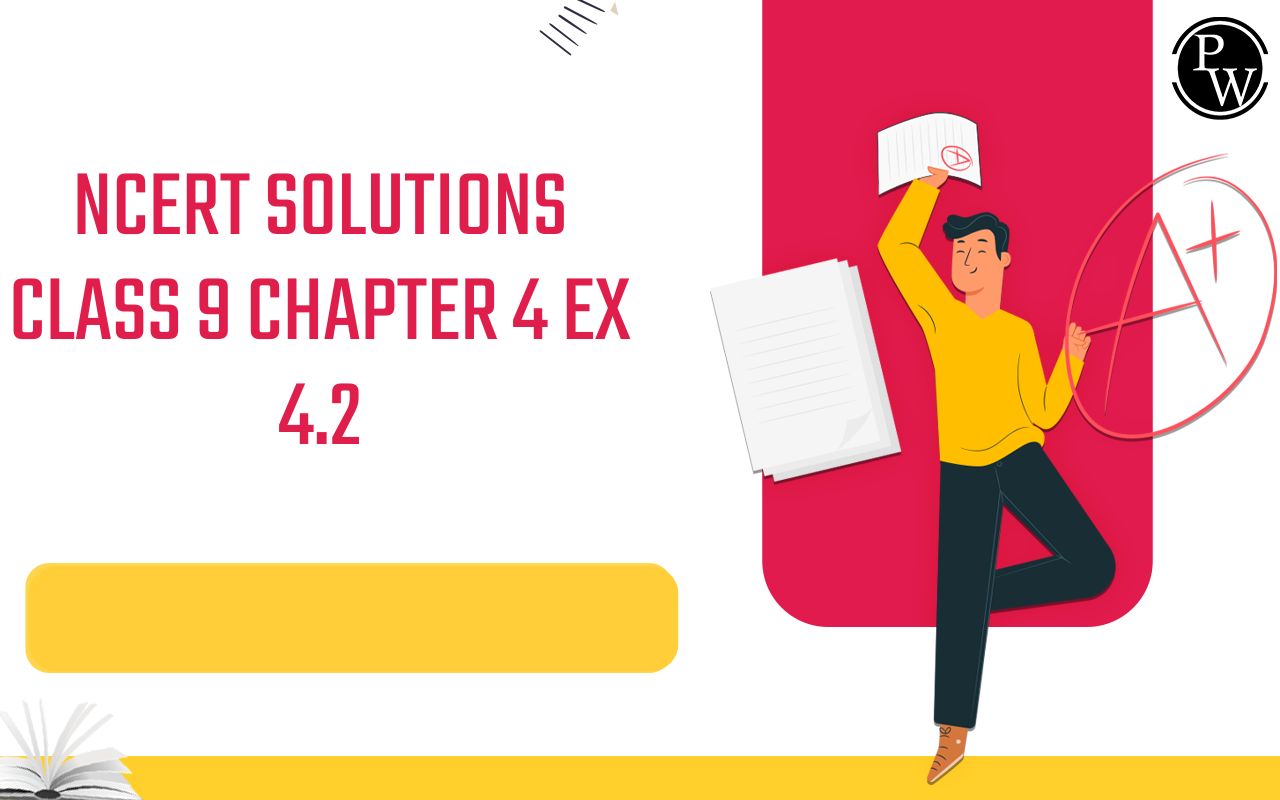

NCERT Solutions for Class 9 Science Chapter 10 make learning the chapter Work and Energy much easier. They provide clear explanations and step-by-step answers for all questions, covering key concepts like work, energy, power, kinetic energy, potential energy, and the law of conservation of energy.
These solutions not only help students understand theory and solve numerical problems but also make it easier to follow the Class 9 syllabus and get familiar with the exam pattern. Practicing with these solutions builds a strong foundation, boosts problem-solving skills, and helps students perform confidently in science exams.
NCERT Solutions Class 9 Science Chapter 10
In our daily life, we often use the words work and energy, but in science, they have a more specific meaning. This chapter explains what work really means in physics and how it is related to energy. Students learn about positive and negative work, different forms of energy, kinetic energy, potential energy, the work-energy theorem, and the law of conservation of energy.
The chapter also connects these concepts to real-life situations, showing how energy is transformed from one form to another and why energy can never be created or destroyed. Understanding this chapter helps students build a strong base for higher classes and apply scientific principles to everyday life.
Class 9 Science Chapter 10 Question Answer
Given below are the NCERT Class 9 Science Chapter 10 Exercise Solutions, explained step by step to help students understand both theory and numerical questions with ease.
1. A force of 7 N acts on an object. The displacement is, say 8 m, in the direction of the force. Let us take it that the force acts on the object through the displacement. What is the work done in this case?
Solution:
When a force F acts on an object to move it in its direction through a distance S, work is done. The work on the body is done by force. Work done = Force × Displacement W = F × S Where, F = 7 N S = 8 m So, work done, W = 7 × 8 W = 56 Nm W = 56 JNCERT Solutions Class 9 Science Chapter 10 Exercise 10.2
1. When do we say that work is done?
Solution:
Work is finished as soon as the following requirements are met: (i) The body is subject to a force. (ii) The body is moved by exerting force in the force's direction or the opposite direction.2. Write an expression for the work done when a force is acting on an object in the direction of its displacement.
Solution:
The work done W on a body when a force F moves it over a distance S in the direction of the applied force is expressed as follows:3. Define 1 J of work.
Solution:
An object undergoes 1 J of work when a force of 1 N moves it 1 m along the force's line of action.4. A pair of bullocks exert a force of 140 N on a plow. The field being ploughed is 15 m long.
How much work is done in ploughing the length of the field?
Solution:
Work done by the bullocks is given by the expression: W= F × d Where, Applied force, F = 140 N Displacement, d = 15 m W = 140 x 15 = 2100 J Therefore, 2100 J of work is done in ploughing the length of the field.NCERT Solutions Class 9 Science Chapter 10 Exercise 10.3
1. What is the kinetic energy of an object?
Solution:
The energy that a body possesses as a result of motion is referred to as kinetic or mechanical energy. Everything in motion has mechanical energy. The body tries to function by using mechanical energy. A nail is driven into a log of wood using the kinetic energy of the hammer, windmills are operated by the mechanical energy of air, etc.2. Write an expression for the kinetic energy of an object.
Solution:
If a body of mass m is moving with a speed v, then its K.E. E k is given by the expression, E k = 1/2 m v 2 Its SI unit is Joule (J).3. The kinetic energy of an object of mass, m moving with a velocity of 5 ms -1 is 25 J. What will be its kinetic energy when its velocity is doubled? What will be its kinetic energy when its velocity is increased three times?
Solution:
Given K.E. of the object = 25J Velocity of the object (v) = 5 m/s K.E. = (½) mv 2 25 = (½) m (5) 2 50 = 25 x m m = 50/25 m = 2 kg Now, when velocity is doubled v = 10 m/s m = 2 kg K.E. = (½) x 2 x (10) 2 K.E. = 10 2 K.E. = 100 J When velocity is increased three times, then v = 15 m/s m = 2 kg K.E. = (½) x 2 x (15) 2 K.E. = (15) 2 K.E. = 225 JNCERT Solutions Class 9 Science Chapter 10 Exercise 10.4
1. What is power?
Solution:
Power is defined as the rate of doing work or the rate of transfer of energy. If an agent does a work W in time t, then power is given by: P = W/T It is expressed in watt (W).
P = W/T It is expressed in watt (W).
2. Define 1 watt of power.
Solution:
A body is claimed to possess power of one watt if it works at the speed of 1 joule in 1 s. That is, One W = 1 J/1 S3. A lamp consumes 1000 J of electrical energy in 10 s. What is its power?
Solution:
Power = Work/Time P = W/T Time = 10 s Work done = Energy consumed by the lamp = 1000 J Power = 1000/10 = 100 Js -1 =100 W Hence, the power of the lamp is 100 W4. Define average power.
Solution:
Average power is defined as the ratio of total work done by the body to the total time taken by the body.
NCERT Solutions Class 9 Science Chapter 10 Exercise 10.5
1. Look at the activities listed below. Reason out whether or not work is done in the light of your understanding of the term ‘work’.
(a) Suma is swimming in a pond.
(b)A donkey is carrying a load on its back.
(c) A windmill is lifting water from a well.
(d) A green plant is carrying out photosynthesis.
(e) An engine is pulling a train.
(f) Food grains are getting dried in the sun.
(g) A sailboat is moving due to wind energy.
Solution:
When both of the following two requirements are met, the work is completed:2. An object thrown at a certain angle to the ground moves in a curved path and falls back to the ground. The initial and the final points of the path of the object lie on the same horizontal line. What is the work done by the force of gravity on the object?
Solution:
Work done by the force of gravity on an object depends solely on vertical displacement. Vertical displacement is given by the distinction in the initial and final positions/heights of the object which is zero. Work done by gravity is given by the expression, W = m × g × h Where, h= Vertical displacement = 0 W = m g × 0 = 0 J Hence, the work done by the gravity on the given object is zero joule.3. A battery lights a bulb. Describe the energy changes involved in the process.
Solution:
The energy in a battery is converted into voltage when a light is connected to it. The voltage is converted into heat and light energy by the lightbulb once it has received it. As a result, the energy transformation in the given scenario can be represented as follows: Chemical Energy → Electrical Energy → Light Energy + Heat Energy.4. Certain force acting on a 20 kg mass changes its velocity from 5 m s -1 to 2 m s -1 . Calculate the work done by the force.
Solution:
Given Initial velocity u = 5 m/s Mass of the body = 20kg Final velocity v = 2 m/s The initial kinetic energy E i = (1/2) mu 2 = (1/2) × 20 × (5) 2 = 10 × 25 = 250 J Final kinetic energy E f = (1/2) mv 2 = (1/2) × 20 × (2) 2 = 10 × 4 = 40 J Therefore, Work done = Change in kinetic energy Work done = E f – E i Work done = 40 J – 250 J Work done = -210 J5. A mass of 10 kg is at point A on a table. It is moved to a point B. If the line joining A and B is horizontal, what is the work done on the object by the gravitational force? Explain your answer.
Solution:
Work done by gravity depends solely on the vertical displacement of the body. It doesn’t rely on the trail of the body. Therefore, work done by gravity is given by the expression, W= m g h Where, Vertical displacement, h = 0 ∴ W= m × g × zero = 0 Therefore the work done on the object by gravity is zero.6. The potential energy of a freely falling object decreases progressively. Does this violate the law of conservation of energy? Why?
Solution:
The energy conservation law is not broken by this procedure. This is because the body gradually transforms its potential energy into kinetic energy when it descends from a height. The body's kinetic energy increases in proportion to a decrease in potential energy. The body's whole mechanical energy is conserved during the process. As a result, the law of energy conservation remains intact.7. What are the various energy transformations that occur when you are riding a bicycle?
Solution:
The muscle energy of a bicycle rider is converted into mechanical energy and heat during the ride. The bicycle is propelled by kinetic energy, while our bodies are heated by thermal energy. Muscular energy → mechanical energy + heat8. Does the transfer of energy take place when you push a huge rock with all your might and fail to move it? Where is the energy you spend going?
Solution:
There is no muscle energy transfer to the stationary rock when we push a large boulder. Additionally, since muscular energy is converted into heat energy, which raises our body's temperature, there is no energy loss.9. A certain household has consumed 250 units of energy during a month. How much energy is this in joules?
Solution:
1 unit of energy = 1kWh Given Energy (E) = 250 units 1 unit = 1 kWh 1 kWh = 3.6 x 10 6 J Therefore, 250 units of energy = 250 × 3.6 × 10 6 = 9 × 10 8 J.10. An object of mass 40 kg is raised to a height of 5 m above the ground. What is its potential energy? If the object is allowed to fall, find its kinetic energy when it is halfway down.
Solution:
Given Mass (m) = 40 kg Acceleration due to gravity (g)= 10m/s² Height (h)= 5m Potential energy= m × g× h P.E= 40 × 10 × 5 = 2000J Potential energy = 2000J ( 2000 joules) At a height of 5 meters, the object has a potential energy of 2000 J. When this object is allowed to fall and it is halfway down, its height above the ground will be half of 5 m= 5/2= 2.5m. P.E at Halfway down= m× g×h P.E= 40× 10 × 2.5= 1000J [h= 2.5 m] Potential Energy halfway down= 1000 joules. According to the law of conservation of energy: Total potential energy potential energy halfway down kinetic energy halfway down 2000 = 1000 + K.E halfway down K.E at halfway down= 2000- 1000= 1000 J Kinetic energy at halfway down 1000 joules.11. What is the work done by the force of gravity on a satellite moving around the earth? Justify your answer.
Solution:
When both of the following two requirements are met, work is considered finished: (i) The body is subject to a force. (ii) The body is moved by exerting force in the force's direction or the opposite direction. The work done is 0 if the force's direction is perpendicular to the displacement. The force of gravity acting on a satellite throughout its orbit around the Earth is perpendicular to the spacecraft's displacement. As a result, Earth has done zero work on the satellite.12. Can there be displacement of an object in the absence of any force acting on it? Think. Discuss this question with your friends and teacher
Solution:
In the absence of any force acting on an object, displacement is indeed possible. An object accelerates when subjected to a single force. An object is subject to a force if it accelerates. Let's say that an object is traveling at a constant speed. There is no net force acting on it. However, the thing moves, and with it, a displacement. Consequently, a displacement is possible in the absence of a force.13. A person holds a bundle of hay over his head for 30 minutes and gets tired. Has he done some work or not? Justify your answer.
Solution:
When the two requirements are met, the work is finished. (i) The body is subject to a force. (ii) The body is moved by exerting force in the force's direction or the opposite direction. There isn't any movement in a hay bundle when someone holds it above their head. The bundle is being affected by the force of gravity, but the individual is not exerting any effort on it. Consequently, the person's work on the bundle is zero in the absence of force.14. An electric heater is rated 1500 W. How much energy does it use in 10 hours?
Solution:
Given, Power of the heater = 1500 W = 1.5 kW Time taken = 10 hours Energy consumed by an electric heater can be obtained with the help of the expression, Power = Energy consumed / Time taken Hence, Energy consumed = Power x Time taken Energy consumed = 1.5 x 10 Energy consumed = 15 kWh Therefore, the energy consumed by the heater in 10 hours is 15 kWh.15. Illustrate the law of conservation of energy by discussing the energy changes that occur when we draw a pendulum bob to one side and allow it to oscillate. Why does the bob eventually come to rest? What happens to its energy eventually? Is it a violation of the law of conservation of energy?
Solution:
Consider the case of an oscillation pendulum. An apparatus rises via a height h on top of the mean level P when it moves from its mean position P to either of its extreme locations A or B. At this point, the bob's K.E. completely transforms into P.E. When this happens, the K.E. drops to zero and the bob just has P.E. As it advances in the direction of goal P, its P.E. steadily drops. As a result, the K.E. will rise. The bob's P.E. drops to zero when it achieves goal P, and it likewise just has K.E. For as long as the device oscillates, this technique is perpetual. The bob does not continuously oscillate. Because of the air resistance preventing it from moving, it comes to rest. To overcome this friction, the device occasionally stops and loses its K.E. The energy wasted by the device to overcome friction is recovered by its surroundings, therefore the rule of conservation of energy is not violated. As a result, the apparatus's total energy as well as the surrounding system is maintained.
An apparatus rises via a height h on top of the mean level P when it moves from its mean position P to either of its extreme locations A or B. At this point, the bob's K.E. completely transforms into P.E. When this happens, the K.E. drops to zero and the bob just has P.E. As it advances in the direction of goal P, its P.E. steadily drops. As a result, the K.E. will rise. The bob's P.E. drops to zero when it achieves goal P, and it likewise just has K.E. For as long as the device oscillates, this technique is perpetual. The bob does not continuously oscillate. Because of the air resistance preventing it from moving, it comes to rest. To overcome this friction, the device occasionally stops and loses its K.E. The energy wasted by the device to overcome friction is recovered by its surroundings, therefore the rule of conservation of energy is not violated. As a result, the apparatus's total energy as well as the surrounding system is maintained.
16. An object of mass, m is moving with a constant velocity, v. How much work should be done on the object to bring the object to rest?
Solution:
The kinetic energy of an object of mass m, moving with a velocity, v, is given by the expression, K.E = 1/2 mv 2 To bring it to rest, its velocity has to be reduced to zero, and to accomplish that, the kinetic energy has to be drained off and sent somewhere else. An external force has to absorb energy from the object, i.e. do negative work on it, equal to its kinetic energy, or – 1/2 mv 2 .17. Calculate the work required to be done to stop a car of 1500 kg moving at a velocity of 60 km/h.
Solution:
Given data: The mass of the body = 1500kg Velocity v = 60km/hr The work required to stop the moving car = change in kinetic energy.
The work required to stop the moving car = change in kinetic energy.Class 9 Science Chapter 10 Exercise Question Answers PDF
Students can download the Chapter 10 Science Class 9 Solutions PDF from the link given below. These solutions provide detailed answers to all questions from the NCERT textbook, covering important topics like work, energy, power, kinetic energy, potential energy, and the law of conservation of energy. The PDF makes revision quick and convenient, helping students strengthen their concepts and prepare well for exams.
NCERT Solutions Class 9 Science Chapter 10 PDF
Benefits of NCERT Solutions Class 9 Science Chapter 10
Using NCERT Solutions for Class 9 Science Chapter 10 makes learning easier and more effective. These solutions not only explain concepts but also help students prepare well for exams.
-
The solutions provide detailed answers that make understanding concepts simpler.
-
Important topics like work, energy, and power are explained clearly.
-
Helps students practice a wide range of questions.
-
Working on sample papers improves exam preparation and time management.
-
Previous years’ questions give an idea of the commonly asked questions in exams.
-
Helps prioritize key concepts for better performance in exams.
-
Detailed solutions enhance analytical and problem-solving abilities.
-
Very useful for revising important topics before exams.
-
Builds a strong foundation necessary for higher classes.
-
Practicing with these solutions helps students answer science questions confidently.
NCERT Solutions Class 9 Science Chapter 10 FAQs
What is Chapter 10 of Class 9 Science about?
How do NCERT Solutions help in Chapter 10 Science Class 9?
Are the numerical problems in Chapter 10 solved in these solutions?
Are these solutions useful for exam preparation?












